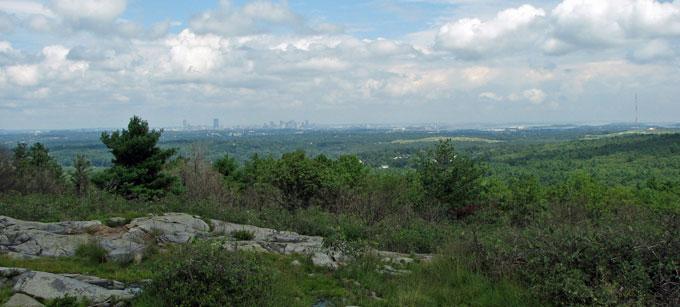These properties provide a variety of recreation opportunities and resources; some are common throughout the Complex while others are less common at both the Complex and Statewide levels. Dog walking, fishing, picnicking, hiking, hunting, indoor ice skating, nature study, and mountain biking are among the common recreation activities. In contrast, disc golf, rock climbing, and the authorized use of OHVs take place at only one, or a few, of the parks. Cultural resources document the region’s human history and include such things as a formal estate with mansion, buildings that tell the story of Massachusetts’s Metropolitan Park System, the remnants of municipal water works that supplied drinking water to an expanding Greater Boston, and a colonial era boundary marker that identifies a bend in the dividing line between the Massachusetts and Plymouth Bay Colonies. Every park protects Massachusetts natural resources; several provide habitat for some of the Commonwealth’s rarest species. Finally, two of the properties are designated Woodlands; these working forests continue to produce forest products, while allowing for recreation and protecting cultural and natural resources.
DCR properties covered in the RMP include: Blue Hills Reservation*, Cutler Park Reservation** (including The Honorable Marie-Louise Kehoe Park), Wilson Mountain Reservation, Neponset River Reservation (upstream of Paul’s Bridge; including Fowl Meadow and the Lt Arthur E. Farnham, Jr., and TSgt Thomas M. Connolly, Jr. Memorial Park), F. Gilbert Hills State Forest (including Barton State Park), Bristol Blake State Reservation, Franklin State Forest, Wrentham State Forest, Rehoboth State Forest, West Bridgewater State Forest, Bridgewater State Forest, and Borderland State Park. Also included in the Complex are historic parkways, fire observation towers, ice rinks, swimming pools, Angle Tree Monument Reservation, and flood control properties.Public input is an important component of the RMP process, providing a forum for communication and cooperation with park visitors, partners, and surrounding communities, and ensuring transparency in the DCR’s stewardship efforts. On October 28, 2015, DCR hosted a public meeting at the Blue Hills Trailside Museum to solicit input regarding recreation, stewardship of resources, and park facilities. A second public meeting was held on November 10, 2016 at the Sharon Public Library to present the draft RMP and hear public questions and comments on the material covered in the plan. Both meetings and open houses were followed by 30-day public comment periods. Public input received at the meetings and during the associated comment periods helped shape the final Nickerson RMP, which was adopted by the DCR Stewardship Council on April 12, 2017.
RMP documents
Section 1. The Blue Hills Complex* Fact Sheet
Section 2. Blue Hills Reservation Blue Hills Map Figure 2.1.1 Blue Hills Zoning Map Figure 2.9.1
Section 3 - Cutler Park Reservation Fact Sheet
Section 4 - Wilson Mountain Reservation Fact Sheet
Section 5 - Neponset River Reservation Fact Sheet
Section 6 - F Gilbert Hills State Forest Fact Sheet
Section 7 - Bristol Blake State Reservation Fact Sheet
Section 8 - Franklin State Forest Fact Sheet
Section 9 - Wrentham State Forest Fact Sheet
Section 10 - Rehoboth State Forest Fact Sheet
Section 11 - West Bridgewater State Forest Fact Sheet
Section 12 - Bridgewater State Forest Fact Sheet 11
Section 13 - Borderland State Park Fact Sheet 12
* The chapter on the Blue Hills Reservation updates, rather than replaces, the 2011 RMP for the Blue Hills Planning Unit. Applicable recommendations contained in the previous plan remain valid unless otherwise indicated.
** This park was operationally removed from the Blue Hills Complex shortly after the adoption of this RMP.
Public process
Public input is an important component of the RMP process, providing a forum for communication and cooperation with park visitors, partners, and surrounding communities, and ensuring transparency in the DCR’s stewardship efforts. On October 28, 2015, DCR hosted a public meeting at the Blue Hills Trailside Museum to solicit input regarding recreation, stewardship of resources, and park facilities. A second public meeting was held on November 10, 2016 at the Sharon Public Library to present the draft RMP and hear public questions and comments on the material covered in the plan. Both meetings and open houses were followed by 30-day public comment periods. Public input received at the meetings and during the associated comment periods helped shape the final Nickerson RMP, which was adopted by the DCR Stewardship Council on April 12, 2017.
Contact
Online
Phone
Open M-F 9am-5pm
